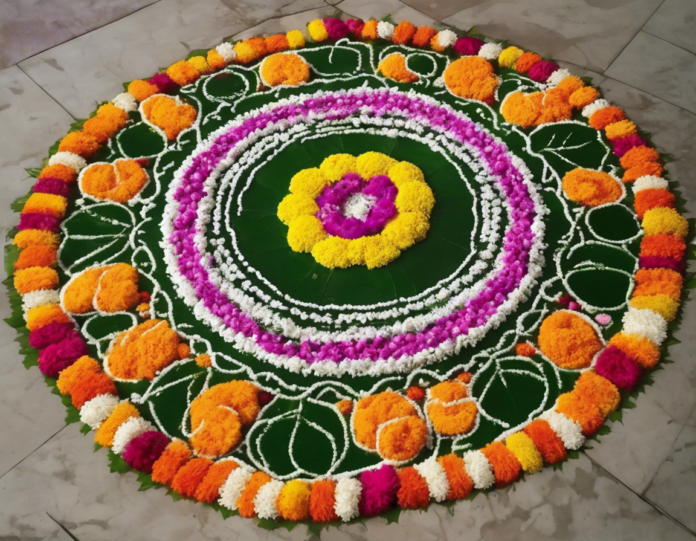Introduction
In Hindu culture, rituals and traditions hold significant importance, marking various occasions and festivals. One such traditional ceremony celebrated with immense fervor is Tulsi Vivah. Tulsi Vivah is the ceremonial marriage of the sacred Tulsi plant (holy basil) to Lord Vishnu. This ritual signifies the end of the monsoon season and the beginning of the wedding season in India. It is believed that performing Tulsi Vivah brings prosperity, happiness, and marital bliss to the household. In this article, we will explore the significance of Tulsi Vivah and provide inspiration for creating stunning rangoli designs to adorn your home during this auspicious occasion.
Significance of Tulsi Vivah
Tulsi holds a sacred place in Hindu mythology and is revered for its medicinal properties as well. According to legend, Tulsi is considered to be an incarnation of Goddess Lakshmi and is believed to bring good luck and prosperity to the household. Tulsi Vivah symbolizes the beginning of the wedding season, and it is believed that by performing this ritual, unmarried individuals are blessed with suitable life partners, and married couples are bestowed with a harmonious married life.
Rangoli Designs for Tulsi Vivah
Rangoli, an art form that involves creating intricate patterns on the floor using colored powders, rice, or flower petals, is a popular traditional practice during festivals and auspicious occasions. Here are some stunning rangoli designs inspired by Tulsi Vivah:
1. Peacock and Lotus Design
– Create a peacock design in the center of the rangoli, symbolizing grace and beauty.
– Surround the peacock with lotus flowers, representing purity and devotion.
– Use vibrant colors like blue, green, and pink to enhance the design.
2. Conch Shell and Diya Design
– Begin by drawing a conch shell in the center of the rangoli, symbolizing the presence of Lord Vishnu.
– Place diyas (oil lamps) around the conch shell, signifying light and positivity.
– Add intricate patterns and floral motifs to complete the design.
3. Tulsi Plant Design
– Dedicate the rangoli to the Tulsi plant by intricately drawing its leaves and flowers.
– Incorporate elements of a traditional wedding ceremony, such as mangal sutra (sacred thread) and sindoor (vermilion).
– Use green, red, and yellow colors to represent the vibrancy of the Tulsi plant.
4. Swastika and Om Design
– Begin by drawing a swastika symbol at the center of the rangoli, symbolizing prosperity and good fortune.
– Surround the swastika with Om symbols, representing the divine energy of the universe.
– Incorporate floral patterns and geometric designs to complement the theme.
Tips for Creating a Stunning Tulsi Vivah Rangoli
- Plan your design: Sketch the design on paper before starting the rangoli to ensure symmetry and balance.
- Use vibrant colors: Opt for bright and contrasting colors to make the rangoli visually appealing.
- Incorporate traditional motifs: Include symbols like diyas, lotus flowers, and conch shells to stay true to the Tulsi Vivah theme.
- Add floral elements: Use fresh flower petals to enhance the beauty and fragrance of the rangoli.
- Practice mindfulness: Create the rangoli with a sense of devotion and mindfulness to truly capture the essence of the occasion.
FAQs (Frequently Asked Questions)
1. What is the significance of Tulsi Vivah in Hindu culture?
Tulsi Vivah symbolizes the ceremonial marriage of the sacred Tulsi plant to Lord Vishnu and marks the beginning of the wedding season in India.
2. Is Tulsi considered auspicious in Hindu mythology?
Yes, Tulsi is highly revered in Hindu mythology and is believed to bring prosperity, happiness, and good health to the household.
3. How can I perform Tulsi Vivah at home?
To perform Tulsi Vivah at home, you can decorate the Tulsi plant with flowers, offer prayers to Lord Vishnu, and recite hymns and mantras dedicated to the occasion.
4. What are the traditional colors used in Tulsi Vivah rangoli designs?
Traditional colors like green (for Tulsi), red (for sindoor), yellow, and vibrant hues are commonly used in Tulsi Vivah rangoli designs.
5. Can I personalize my Tulsi Vivah rangoli design with my own elements?
Absolutely! You can incorporate personal elements, symbols, and motifs that hold significance for you and your family to make the rangoli more meaningful.
6. Is it necessary to use only powdered colors for rangoli designs?
While powdered colors are commonly used for rangoli, you can also experiment with flower petals, rice grains, colored sand, or even eco-friendly rangoli sticker sheets for a unique touch.
7. How long does a typical Tulsi Vivah rangoli last?
Depending on the materials used, a Tulsi Vivah rangoli can last anywhere from a few hours to a few days. It is advisable to create it on the day of the celebration for a fresh and vibrant display.
8. Can children participate in creating Tulsi Vivah rangoli designs?
Yes, involving children in creating Tulsi Vivah rangoli designs can be a fun and educational activity. It helps instill a sense of tradition and creativity in them.
9. Are there any superstitions or taboos associated with Tulsi Vivah rangoli designs?
While there are no specific superstitions, it is advisable to avoid stepping on or crossing over the rangoli as a sign of respect for the art and the occasion.
10. Can I preserve my Tulsi Vivah rangoli design after the celebration?
You can attempt to preserve your Tulsi Vivah rangoli design by taking a photograph or using techniques like spraying a fixative to help retain the colors and patterns for a longer duration.
In conclusion, Tulsi Vivah is a sacred and joyous occasion in Hindu culture, and embellishing your home with a beautiful rangoli design adds to the festive spirit. By following the tips and drawing inspiration from the suggested designs, you can create a mesmerizing Tulsi Vivah rangoli that will not only adorn your doorstep but also bring blessings and prosperity to your household.









